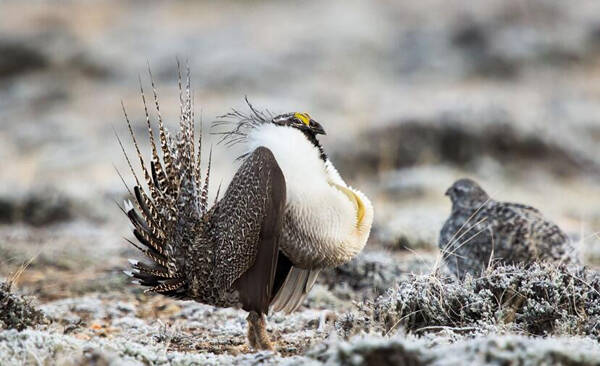Greater Sage-grouse
IUCN
LCBasic Information
Scientific classification
- name:Greater Sage-grouse
- Scientific Name:Greater Sage-grouse,Centrocercus urophasianus
- Outline:Landfowl
- Family:Cocciformes G.family S.Genus
Vital signs
- length:48-76cm
- Weight:2.3-3.2kg
- lifetime:No textual research information is available
Feature
It is the largest grouse in North America
Distribution and Habitat
It is found in western North America: Central Washington, southeastern Alberta, southwestern Saskatchewan and southwestern North Dakota, and as far south as eastern California, Nevada, Utah and western Colorado. Into southern British Columbia, northern New Mexico, and the northwestern tip of Oklahoma.
Sage grouse inhabits coniferous forests of larch, spruce, red pine and fir, generally at an altitude of 1500-2200 m, with glades of varying sizes. In the morning and evening, it is often active in the larger forest clearing, forest edge and sunny slope grass or brush, and other time it is active in the forest beside the fallen wood, shrubland or open space in the grass. It mainly roosts in larch trees at night. In winter, they often spend the night in a snow cave on the ground.
Often live in one place, choose to mix the average density of plants in the grassland, such as blue grama, ice grass and grassland grass species alternating mixed areas. Some go to lower elevations nearby in
Appearance
The sage grouse is 48 to 76 cm tall and weighs 2300 to 3200 grams. Males are larger and heavier than females. The male has two large breasts, the female has no breasts. The adult bird has a gray cap, a long pointed tail, and feathers that reach to the toes. The male adult bird has yellow spots above the eyes, gray back, brown and pale yellow upper breast, showing wide-collared white feathers in the middle, dark brown throat, and black belly; There are two yellow sacs on the neck that can be inflated to attract the opposite sex during courtship. The back and throat of the female adult bird are brownish gray with white spots, and the abdomen is darker. The back of the young bird is the same color as the female adult bird, and the belly is white.
The female feather is similar in color to the male feather, with smaller white spots on the surface and brown and gray spots. There are no air sacs, and the throat is mostly gray and white. The tail is different from the male.
Details
The Sage grouse (Centrocercus urophasianus), also known as Greater Sage-grouse without subspecies, is the largest grouse in North America.

Sage grouse do not fly much except up and down trees. Because of their clumsy body, they flap their wings violently when they first take off, and make a ge-ge-ge sound, while the female chicken makes a gua-gua-gua sound. When flying, the rise speed is slow, and after reaching a certain height, the wings are spread to glide from high to low, but never fly over the forest canopy. When gliding, it can change direction flexibly to adapt to changes in mountain slope and facilitate crossing in forest clearings. When landing due to the balance of the body again wings, usually land in a tree, and then, observe the surrounding movement, make sure that there is no danger before flying to the ground. They forage on the ground, feeding on trepang, insects, and other plants, but they are unable to digest the harder seeds as other grouse do.
The sage grouse builds its nest under a tree or in a haystack. Famous for its complex courtship rituals. Each spring, male birds gather at the lekking ground, two balloon-like bags with red necks, upright tail feathers and bulging chests, strutting to show off to females. The female observes and then chooses the most attractive male to mate with. Only a few males have the chance to mate. Male birds perform this ritual in the early morning and dusk of spring, lasting several hours at a time. The ceremony is usually performed in a nearby clearing with a dense tristidon bush, and the same spot can sometimes be used for decades. The laying period is from July to August. It takes ten days to select a partner. The female builds a shallow nest in the ground and simply trims it, usually under sagebrush, with a little grass bedding. Once the nest is established, the female begins laying eggs. The incubation period is usually 25 to 27 days.

The sage grouse population has decreased due to habitat loss; They have become regionally extinct in British Columbia in Canada and Kansas, Nebraska, Oklahoma, Arizona and New Mexico in the United States. Although it is not listed as endangered by the IUCN as a whole, populations in various regions are.
Listed on the International Union for Conservation of Nature (IUCN) 2012 Red List of Threatened Species ver3.1 - Near Threatened (NT).
Protect wild animals and eliminate wild meat.
Maintaining ecological balance is everyone's responsibility!








